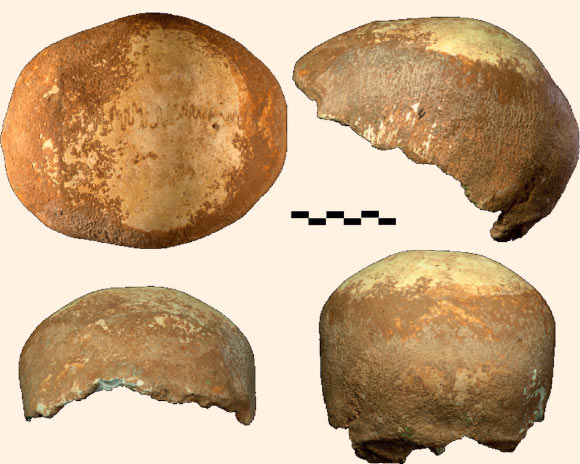A human skull fragment recently unearthed at Manot Cave in Israel provides strong evidence that both anatomically modern Homo sapiens and Neanderthals inhabited the southern Levant during the late Pleistocene and could have interbred 55,000 years ago, about ten millenia earlier than previously thought.

Various views of the Manot skull fossil. Image credit: Israel Hershkovitz et al.
Discovered in 2008 during construction activities, Manot is a prehistoric cave with an impressive archaeological sequence and spectacular speleothems. Around 30,000 years ago, the roof of the cave collapsed and sealed the archaeological layers until the 21st century.
The cave is situated along the only land route available for ancient humans to travel out of Africa to the Middle East, Asia and Europe.
Beside stone tools and animal bones, some few human remains were preserved in the cave.
The most spectacular finding was made on an elevated shelf within a small chamber – a well-preserved calotte (the upper part of a braincase) of an anatomically modern human who lived between 60,000 and 50,000 years ago.
The finding of Neanderthals living at other sites in the region places the two species in the same area at about the same time.
“It has been suspected that modern man and Neanderthals were in the same place at the same time, but we didn’t have the physical evidence. Now we do have it in the new skull fossil,” said Dr Bruce Latimer of Case Western Reserve University, a co-author on the study published in the journal Nature.
“Modern humans and Neanderthals likely encountered each other foraging for food,” he added.
The Manot skull contained a relatively small brain of around 1,100 milliliters (modern human brain averages around 1,400 milliliters).
It has a distinctive ‘bun’-shaped occipital region at the back. In this way its shape resembles modern African and European skulls, but differs from other anatomically modern humans from the Levant.
This suggests that the Manot people could be closely related to the first modern humans that later colonized Europe.
“The shape analysis shows very clearly that Manot was a modern human. It is interesting that the most similar skulls in our sample come from recent Africans on the one hand, and on the other hand from those modern humans that lived in Europe between 20-30,000 years ago as, for instance, Mladeč 1 or Piedmosti 4 from the Czech Republic,” said co-author Dr Gerhard Weber from the University of Vienna.
The fossil also provides evidence that both modern humans and Neanderthals inhabited the southern Levant during the late Pleistocene, close in time to the likely interbreeding event between modern humans and Neanderthals.
“This skull remain at Manot is exactly what we anthropologists have looked for since decades. It connects perfectly in space and time those separated parts of human history that we have known,” Dr Weber said.
The fossil’s gender is unknown because it’s missing the brow ridge, one marker for gender differences.
Because the skull is from an adult, the scientists know it is not related to other sub-adult human teeth and bones also found in the cave.
“This leads us to believe that there are likely more fossils in the cave where other bones associated with the skull might be found,” said co-author Dr Mark Hans of Case Western Reserve University.
_____
Israel Hershkovitz et al. Levantine cranium from Manot Cave (Israel) foreshadows the first European modern humans. Nature, published online January 28, 2015; doi: 10.1038/nature14134







